INSTITUT SUPERIEUR D'ANTHROPOLOGIE
INSTITUTE OF ANTHROPOLOGY
ONLINE COURSES / COURS A DISTANCE
SPRING TERM : APRIL 2014
REGISTER NOW
SUISSE – 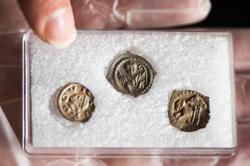 Col du Brünig - Des archéologues ont découvert au col du Brünig plus de 120 pièces de monnaie datant de la création de la Confédération. Les scientifiques, qui ont trouvé les pièces de monnaie, pensent que cet argent a été perdu ou caché par un voyageur. Les pièces ont été trouvées entre de grosses pierres près d'un sentier au-dessus du village de Lungern (OW). Une vingtaine d'archéologues du Groupe de travail prospection (GTP) et des étudiants de l'Université de Bâle ont travaillé sur ce site en septembre 2013, a indiqué jeudi le département obwaldien de l'éducation. Les pièces découvertes sont des Pfennigs datant de la deuxième moitié du 13e siècle. Deux tiers des pièces ont été frappés dans l'évêché de Bâle. Le reste provient de Zurich, Schaffhouse, Villingen (D) et Strasbourg (F). Pour les scientifiques, il est probable que ces pièces ont été cachées par un voyageur dans les années 1280 ou 1290 ou qu'il les a perdues. Le site de la découverte est proche d'un ancien sentier utilisé par des commerçants et qui reliait Lucerne à l'Oberland bernois et le Valais à l'Italie.
Col du Brünig - Des archéologues ont découvert au col du Brünig plus de 120 pièces de monnaie datant de la création de la Confédération. Les scientifiques, qui ont trouvé les pièces de monnaie, pensent que cet argent a été perdu ou caché par un voyageur. Les pièces ont été trouvées entre de grosses pierres près d'un sentier au-dessus du village de Lungern (OW). Une vingtaine d'archéologues du Groupe de travail prospection (GTP) et des étudiants de l'Université de Bâle ont travaillé sur ce site en septembre 2013, a indiqué jeudi le département obwaldien de l'éducation. Les pièces découvertes sont des Pfennigs datant de la deuxième moitié du 13e siècle. Deux tiers des pièces ont été frappés dans l'évêché de Bâle. Le reste provient de Zurich, Schaffhouse, Villingen (D) et Strasbourg (F). Pour les scientifiques, il est probable que ces pièces ont été cachées par un voyageur dans les années 1280 ou 1290 ou qu'il les a perdues. Le site de la découverte est proche d'un ancien sentier utilisé par des commerçants et qui reliait Lucerne à l'Oberland bernois et le Valais à l'Italie.
http://www.tdg.ch/suisse/D-anciennes-pieces-de-monnaies-trouvees-au-col-du-Bruenig/story/22058118
TURQUIE – 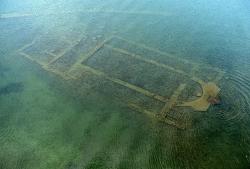 Iznik - A church which dates back to year 500 was unearthed during excavations conducted under in the depths of Lake İznik located western province of Bursa. Explaining the details of the discovery, Professor Mustafa Şahin from Uludağ University’s Archaeology department told Cihan news agency that first traces of the church was first seen 20 meters below a beach and they have been conducting the excavations to get more clues about the church. Byzantine experts are still carrying out some researches to whom the church was belonged to but it has been predicted that the name of the church is St. Peters Church which was mentioned in some Christian books, said Şahin. An archaeological study as part of efforts for İznik to be listed World Heritage List of the United Nations Educational, Scientific and Cultural Organization (UNESCO) paved way for the launch of the excavation. “The building has a structure of a basilica which consists of three columns. Such buildings were originally used as court buildings during the Roma age. In 313 when Christianity was declared as the official religion, devout Christians applied the same structure to the churches they built,” noted the professor. The exact date when the church was built is not known yet but the archaeologists predicted that it must have been built in 500. The details of the church will be released in line with the excavations, added Şahin.
Iznik - A church which dates back to year 500 was unearthed during excavations conducted under in the depths of Lake İznik located western province of Bursa. Explaining the details of the discovery, Professor Mustafa Şahin from Uludağ University’s Archaeology department told Cihan news agency that first traces of the church was first seen 20 meters below a beach and they have been conducting the excavations to get more clues about the church. Byzantine experts are still carrying out some researches to whom the church was belonged to but it has been predicted that the name of the church is St. Peters Church which was mentioned in some Christian books, said Şahin. An archaeological study as part of efforts for İznik to be listed World Heritage List of the United Nations Educational, Scientific and Cultural Organization (UNESCO) paved way for the launch of the excavation. “The building has a structure of a basilica which consists of three columns. Such buildings were originally used as court buildings during the Roma age. In 313 when Christianity was declared as the official religion, devout Christians applied the same structure to the churches they built,” noted the professor. The exact date when the church was built is not known yet but the archaeologists predicted that it must have been built in 500. The details of the church will be released in line with the excavations, added Şahin.
http://en.cihan.com.tr/news/1500-year-old-church-discovered-under-Lake-Iznik_4313-CHMTM0NDMxMy80
FRANCE – 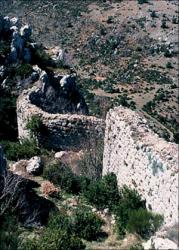 Ollioules - Le patrimoine d’Ollioules est riche. Riche en histoire, une histoire qui remonte à plus de 2.000 ans avec la création par les Ligures d’un oppidum sur la colline de la Courtine qui domine la ville et ses fameuses gorges.Pendant des siècles, nul ne s’est préoccupé de ce site, même si les habitants du village ont toujours compté les ligures de la Courtine parmi leurs ancêtres. Il a fallu l’esprit curieux d’un Notaire passionné d’archéologie, Me Jean Layet, dont la propriété familiale se trouvait tout près de Châteauvallon, juste en dessous de l’oppidum, pour tenter d’en savoir un peu plus sur ces mystérieux aïeux. Dans les années 40, en compagnie d’un autre mordu d’archéologie, Casimir Bottin, receveur des Postes à Ollioules, Jean Layet se mit à fouiller scrupuleusement le sommet de la Courtine pour y découvrir, au fil des ans, de nombreux objets. Après la disparition du Notaire, le Centre Archéologique du Var reprit les fouilles en 1984 jusqu’en 1989. Tous les objets furent réunis et se trouvent aujourd’hui exposés au Local Bottin – Layet (Traverse du Lançon).Tous? Pas tout à fait. « Il y a quelque temps, nous avons trouvé dans notre propriété un carton oublié depuis quelque 70 ans contenant des objets soigneusement enveloppés dans du papier journal. Tout de suite, grâce aux annotations, nous avons compris qu’ils provenaient du site de la Courtine » raconte Me André Layet, Notaire et fils de Jean Layet qui avait débuté les fouilles de l’oppidum. Il ajoute : « Nous avons aussitôt pensé que tout cela revenait de droit à la commune d’Ollioules ».Ce petit trésor archéologique est constitué d’une magnifique meule qui servait à moudre le grain, de pièces de monnaie, de minuscules aiguilles, de notes détaillées, d’éditions très rares consacrées à l’histoire d’Ollioules…Le tout rejoindra le Local Bottin-Layet après inventaire.
Ollioules - Le patrimoine d’Ollioules est riche. Riche en histoire, une histoire qui remonte à plus de 2.000 ans avec la création par les Ligures d’un oppidum sur la colline de la Courtine qui domine la ville et ses fameuses gorges.Pendant des siècles, nul ne s’est préoccupé de ce site, même si les habitants du village ont toujours compté les ligures de la Courtine parmi leurs ancêtres. Il a fallu l’esprit curieux d’un Notaire passionné d’archéologie, Me Jean Layet, dont la propriété familiale se trouvait tout près de Châteauvallon, juste en dessous de l’oppidum, pour tenter d’en savoir un peu plus sur ces mystérieux aïeux. Dans les années 40, en compagnie d’un autre mordu d’archéologie, Casimir Bottin, receveur des Postes à Ollioules, Jean Layet se mit à fouiller scrupuleusement le sommet de la Courtine pour y découvrir, au fil des ans, de nombreux objets. Après la disparition du Notaire, le Centre Archéologique du Var reprit les fouilles en 1984 jusqu’en 1989. Tous les objets furent réunis et se trouvent aujourd’hui exposés au Local Bottin – Layet (Traverse du Lançon).Tous? Pas tout à fait. « Il y a quelque temps, nous avons trouvé dans notre propriété un carton oublié depuis quelque 70 ans contenant des objets soigneusement enveloppés dans du papier journal. Tout de suite, grâce aux annotations, nous avons compris qu’ils provenaient du site de la Courtine » raconte Me André Layet, Notaire et fils de Jean Layet qui avait débuté les fouilles de l’oppidum. Il ajoute : « Nous avons aussitôt pensé que tout cela revenait de droit à la commune d’Ollioules ».Ce petit trésor archéologique est constitué d’une magnifique meule qui servait à moudre le grain, de pièces de monnaie, de minuscules aiguilles, de notes détaillées, d’éditions très rares consacrées à l’histoire d’Ollioules…Le tout rejoindra le Local Bottin-Layet après inventaire.
http://www.ouest-var.net/actualite/ollioules-patrimoine-la-commune-herite-d-un-tresor-archeologique-vieux-de-2-000-ans-8116.html
FRANCE –  Val Bodron - Des fouilles archéologiques ont été entamées au mois octobre sur le site du Val Bodron. Elles se poursuivent malgré des conditions météo déplorables. En 2009, il a été relevé sur cette partie du territoire communal du Porhöet un vaste enclos agricole remontant à environ 250 ans avant J-C. Les fouilles actuelles s'étendent sur près de 3 ha. Les archéologues ont d'abord procédé au décapage de la terre végétale. Cela a permis, en fonction des natures et couleurs du sous-sol, d'identifier l'emplacement des constructions. Il s'agit d'un imposant enclos circulaire entouré de fossés servant à la fois de protection, drainages, voire de dépotoirs. Une plus petite surface intérieure était réservée à l'habitat. Il a été aussi répertorié un puits creusé dans le schiste et l'emplacement d'un grenier à céréales. Des fragments de poteries ont également été découverts. Ces derniers confirment la datation du site.
Val Bodron - Des fouilles archéologiques ont été entamées au mois octobre sur le site du Val Bodron. Elles se poursuivent malgré des conditions météo déplorables. En 2009, il a été relevé sur cette partie du territoire communal du Porhöet un vaste enclos agricole remontant à environ 250 ans avant J-C. Les fouilles actuelles s'étendent sur près de 3 ha. Les archéologues ont d'abord procédé au décapage de la terre végétale. Cela a permis, en fonction des natures et couleurs du sous-sol, d'identifier l'emplacement des constructions. Il s'agit d'un imposant enclos circulaire entouré de fossés servant à la fois de protection, drainages, voire de dépotoirs. Une plus petite surface intérieure était réservée à l'habitat. Il a été aussi répertorié un puits creusé dans le schiste et l'emplacement d'un grenier à céréales. Des fragments de poteries ont également été découverts. Ces derniers confirment la datation du site.
http://www.ouest-france.fr/des-fouilles-archeologiques-au-hameau-du-val-bodron-1876869
GRECE – 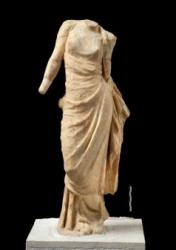 Ambracia - The 33rd Ephorate of Prehistoric and Classical Antiquities of Preveza and Arta and the Archaeological Museum of Arta present the exhibit of the month: a statuette of Aphrodite. The statuette is made of marble. It is dated in the Hellenistic period. It was found in 1985, during excavation works, at Saint Theodoras street, in direct proximity to a Byzantine church of the same name. In Antiquity the prytaneion of Ambracia used to stand at the location of the Byzantine church. The statuette is incomplete. The body leans to its right leg. The goddess wears a himation which covers the legs and passes over the right shoulder so as to accentuate the breast. The garment covers the back of the torso, is twisted around the body and is held by the left hand. According to Dionysius of Halicarnassus the temple of Aeneid Aphrodiate and the monument of Aeneas were located near the so-called Small Theatre of Ambracia. “In Ambracia, there were the temple of Aeneid Aphrodite and the monument of Aeneas, near the small theatre…” (Dionysius Halicarnassus, Roman Archaeology, 1.50). The cult of Aeneid Aphrodite was established by King Pyrrhus and is associated with his grandiose expansionist plans towards Italy.
Ambracia - The 33rd Ephorate of Prehistoric and Classical Antiquities of Preveza and Arta and the Archaeological Museum of Arta present the exhibit of the month: a statuette of Aphrodite. The statuette is made of marble. It is dated in the Hellenistic period. It was found in 1985, during excavation works, at Saint Theodoras street, in direct proximity to a Byzantine church of the same name. In Antiquity the prytaneion of Ambracia used to stand at the location of the Byzantine church. The statuette is incomplete. The body leans to its right leg. The goddess wears a himation which covers the legs and passes over the right shoulder so as to accentuate the breast. The garment covers the back of the torso, is twisted around the body and is held by the left hand. According to Dionysius of Halicarnassus the temple of Aeneid Aphrodiate and the monument of Aeneas were located near the so-called Small Theatre of Ambracia. “In Ambracia, there were the temple of Aeneid Aphrodite and the monument of Aeneas, near the small theatre…” (Dionysius Halicarnassus, Roman Archaeology, 1.50). The cult of Aeneid Aphrodite was established by King Pyrrhus and is associated with his grandiose expansionist plans towards Italy.
http://www.archaiologia.gr/en/blog/2014/01/27/statuette-of-aphrodite/
ROYAUME UNI – 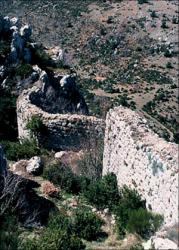 Godalming - During routine archaeological surveys in March a number of skeletons were discovered. Information sent to Surrey County Archaeological Unit, reveals that more than 20 human skeletons were in fact unearthed. The report reads: “From a preliminary assessment, the total number of individuals recovered from the site was one infant, one young adult and 24 adults, but it was impossible to estimate the age at death for the remains of eight individuals due to the fragmentation or poor preservation of the bones.” Alongside the human bones were found animal bone and fragments of medieval and post medieval pottery.Work abruptly halted at the site and the skeletons remain under the car park, as the council runs a public notice to inform the public of its intention to exhume and reinter the human remains “that would be affected by the redevelopment”, at St Peter and St Paul’s church. The council is not forthcoming with information on the topic, but confirmed at the end of last year that “further excavation trenches identified human remains in the east and north of the site, indicating that this part of the site was used as an early Christian burial ground between the ninth and 13th century, before it became disconnected from the church”.
Godalming - During routine archaeological surveys in March a number of skeletons were discovered. Information sent to Surrey County Archaeological Unit, reveals that more than 20 human skeletons were in fact unearthed. The report reads: “From a preliminary assessment, the total number of individuals recovered from the site was one infant, one young adult and 24 adults, but it was impossible to estimate the age at death for the remains of eight individuals due to the fragmentation or poor preservation of the bones.” Alongside the human bones were found animal bone and fragments of medieval and post medieval pottery.Work abruptly halted at the site and the skeletons remain under the car park, as the council runs a public notice to inform the public of its intention to exhume and reinter the human remains “that would be affected by the redevelopment”, at St Peter and St Paul’s church. The council is not forthcoming with information on the topic, but confirmed at the end of last year that “further excavation trenches identified human remains in the east and north of the site, indicating that this part of the site was used as an early Christian burial ground between the ninth and 13th century, before it became disconnected from the church”.
http://www.getsurrey.co.uk/news/local-news/more-details-unearthed-car-park-6556565
MEXIQUE – 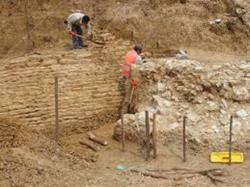 Jaltipan - The archaelogical findingshas being distroyed by the owner of the land,
Jaltipan - The archaelogical findingshas being distroyed by the owner of the land,
http://www.proceso.com.mx/?p=349083